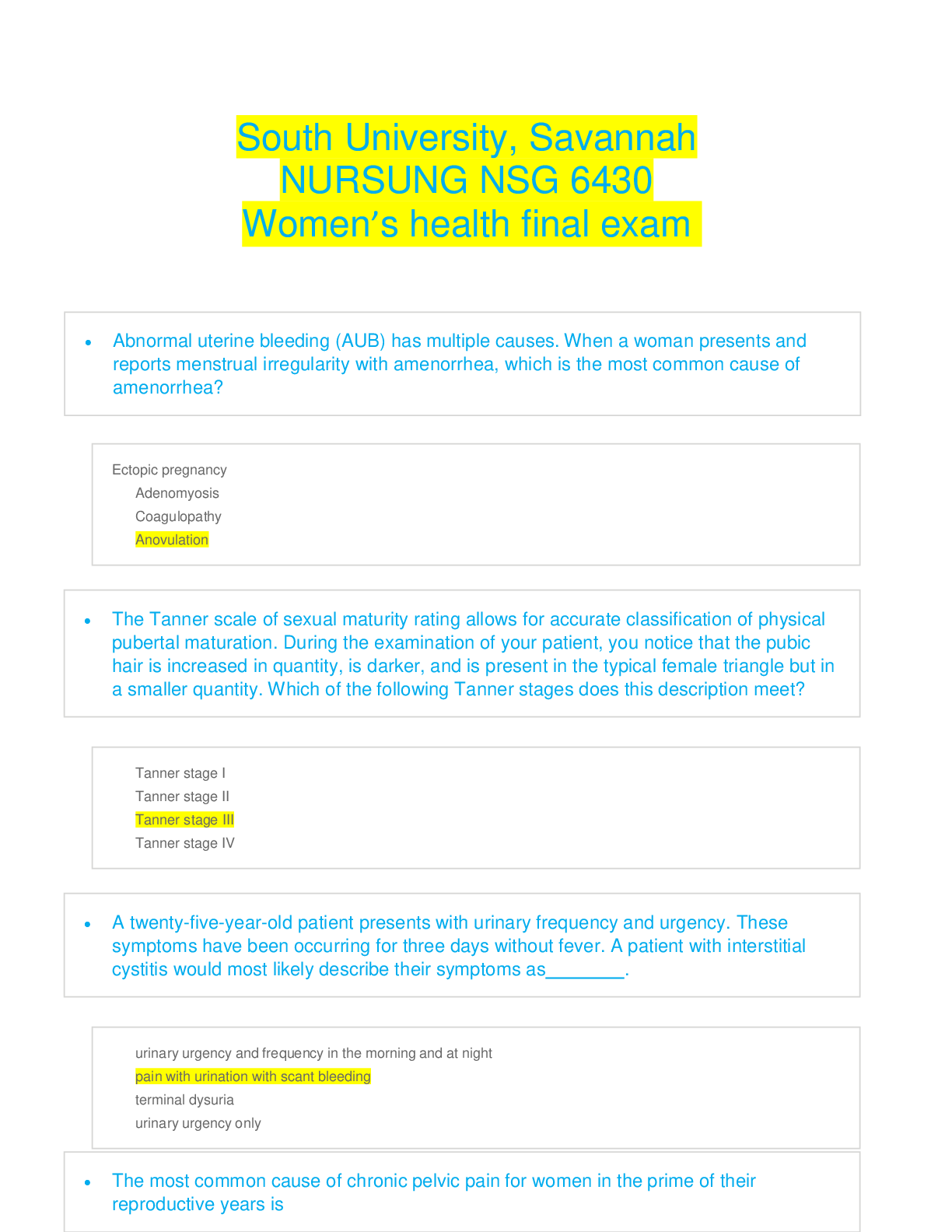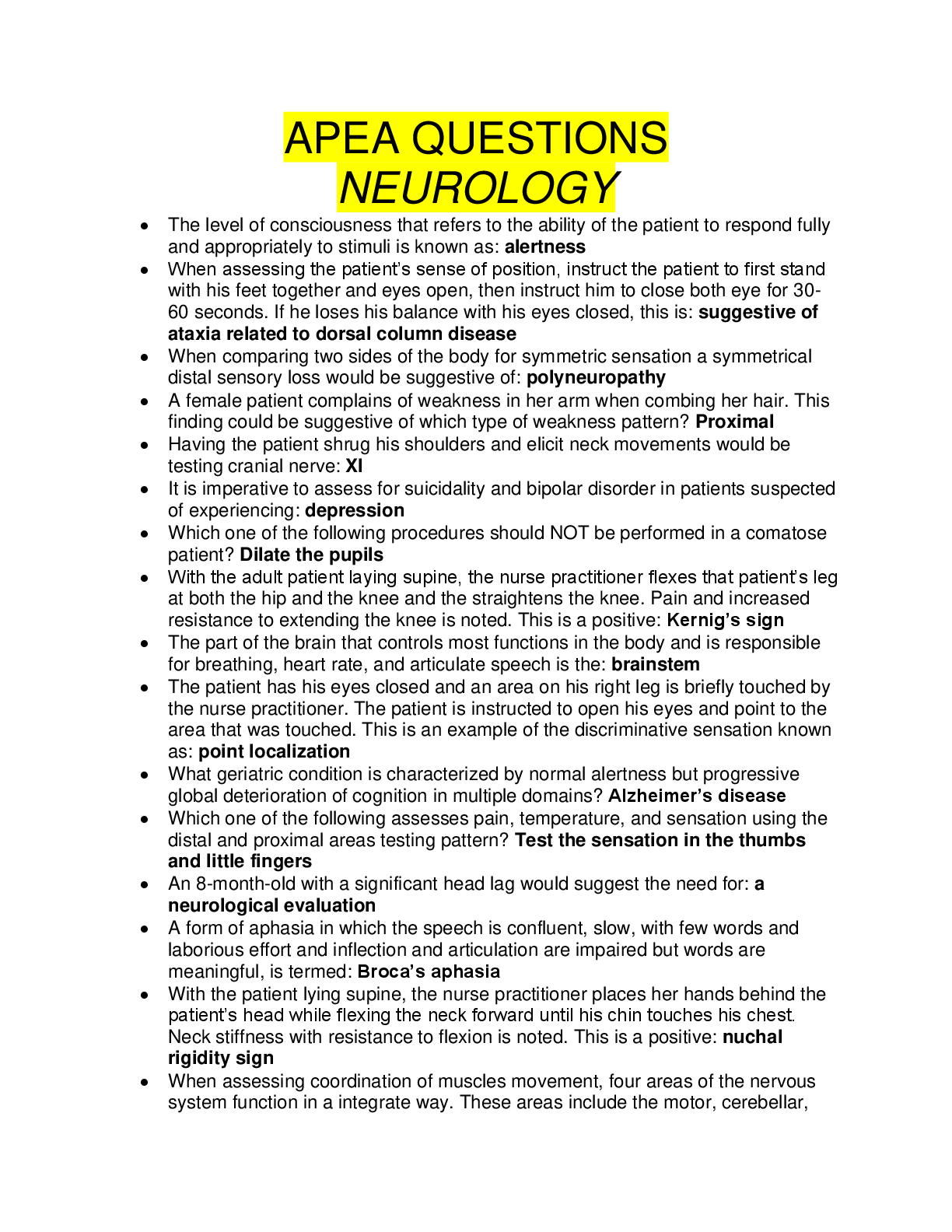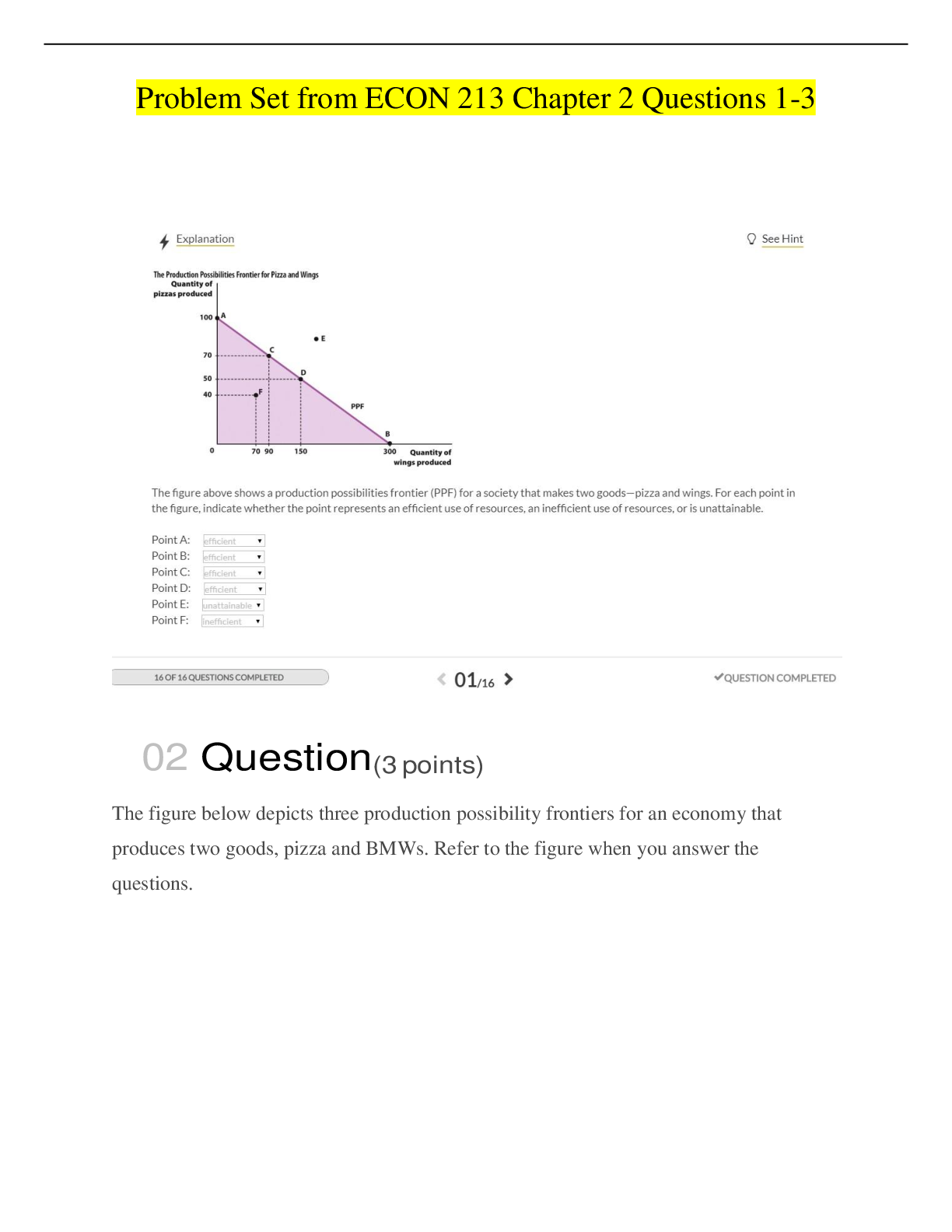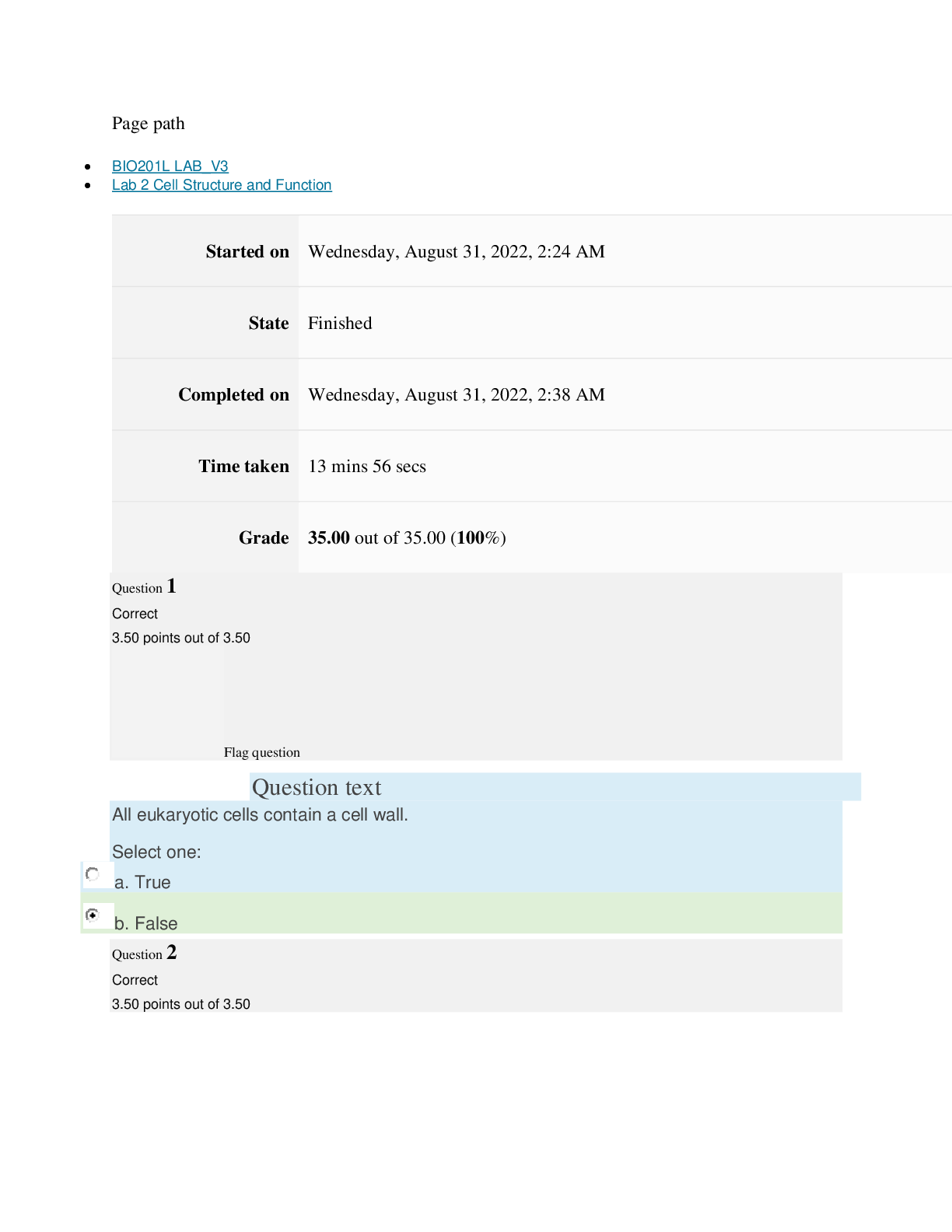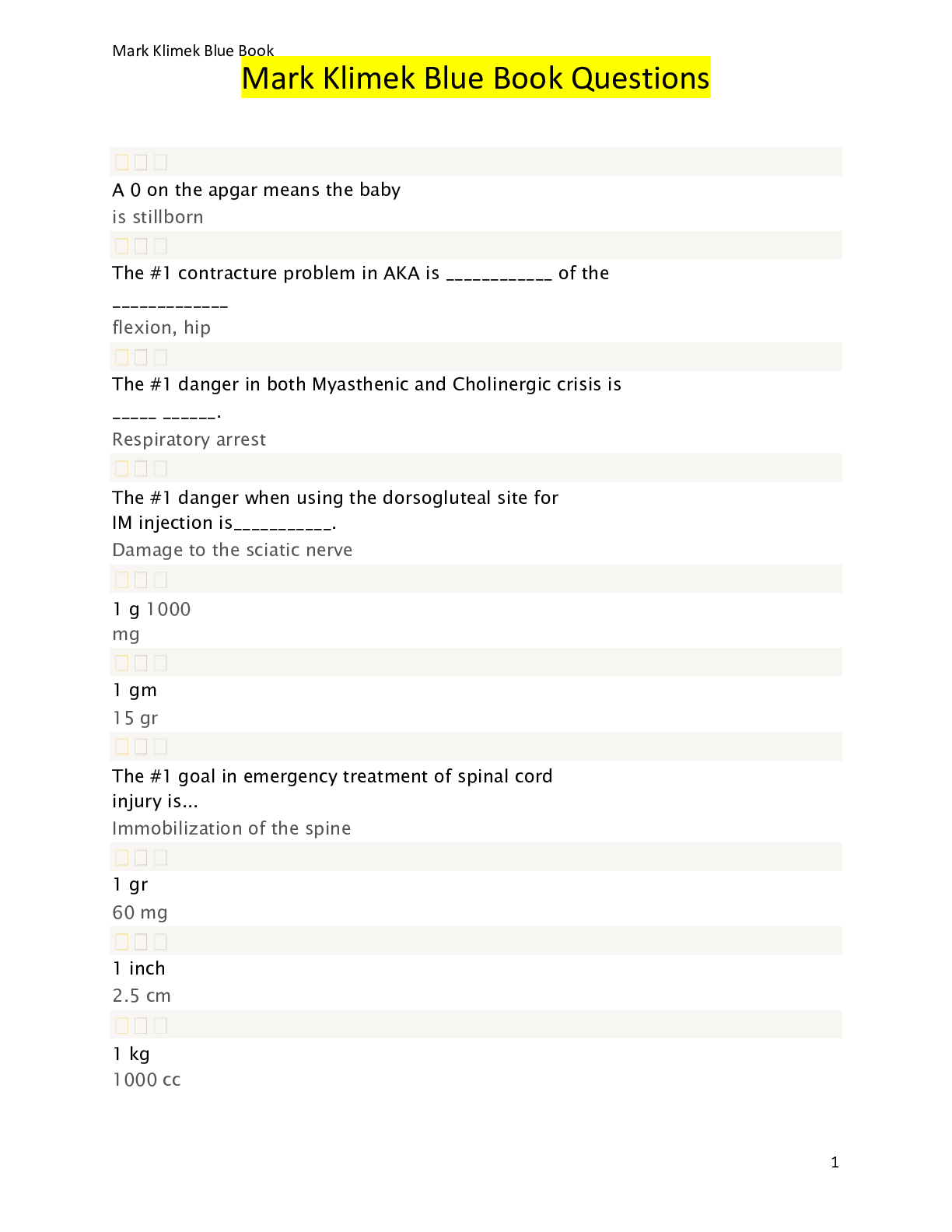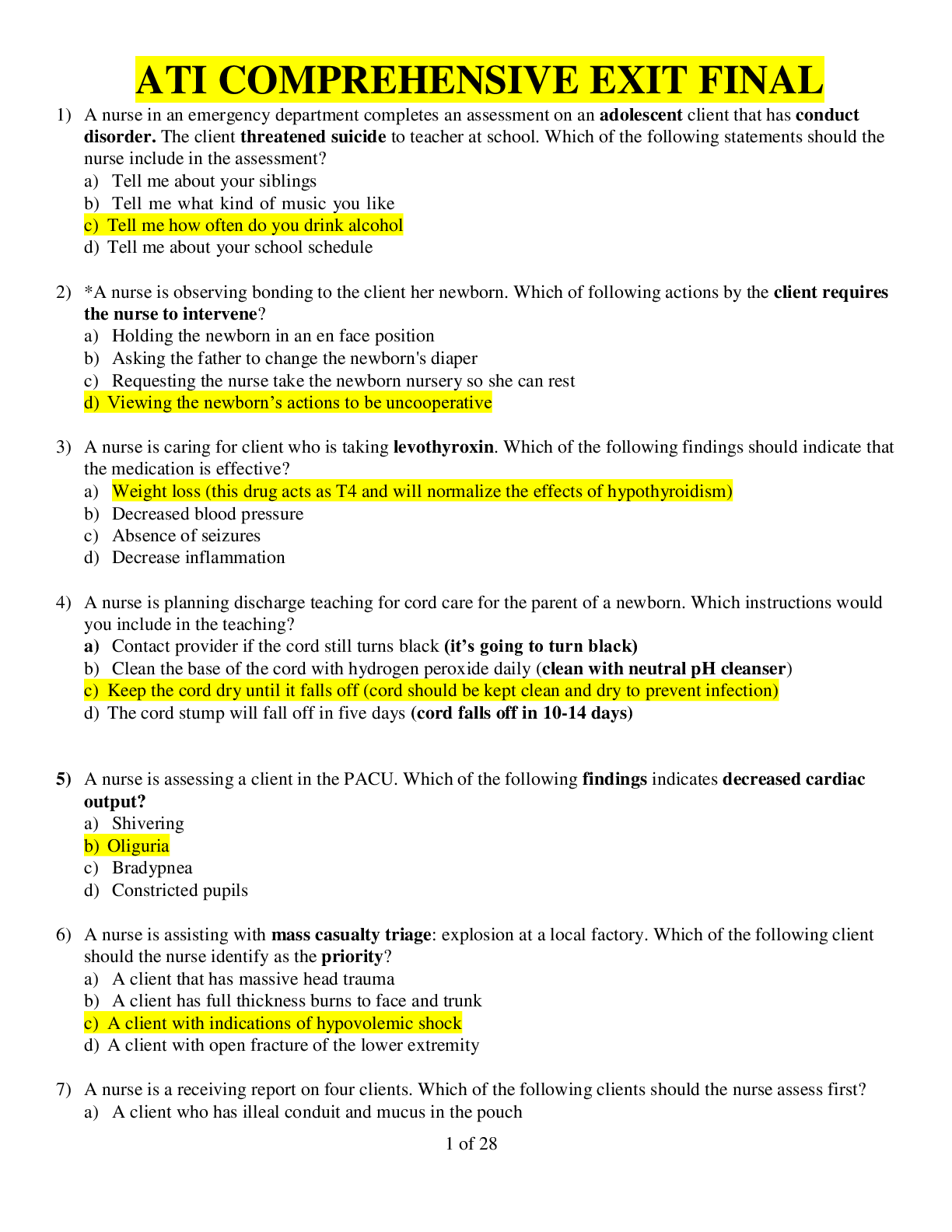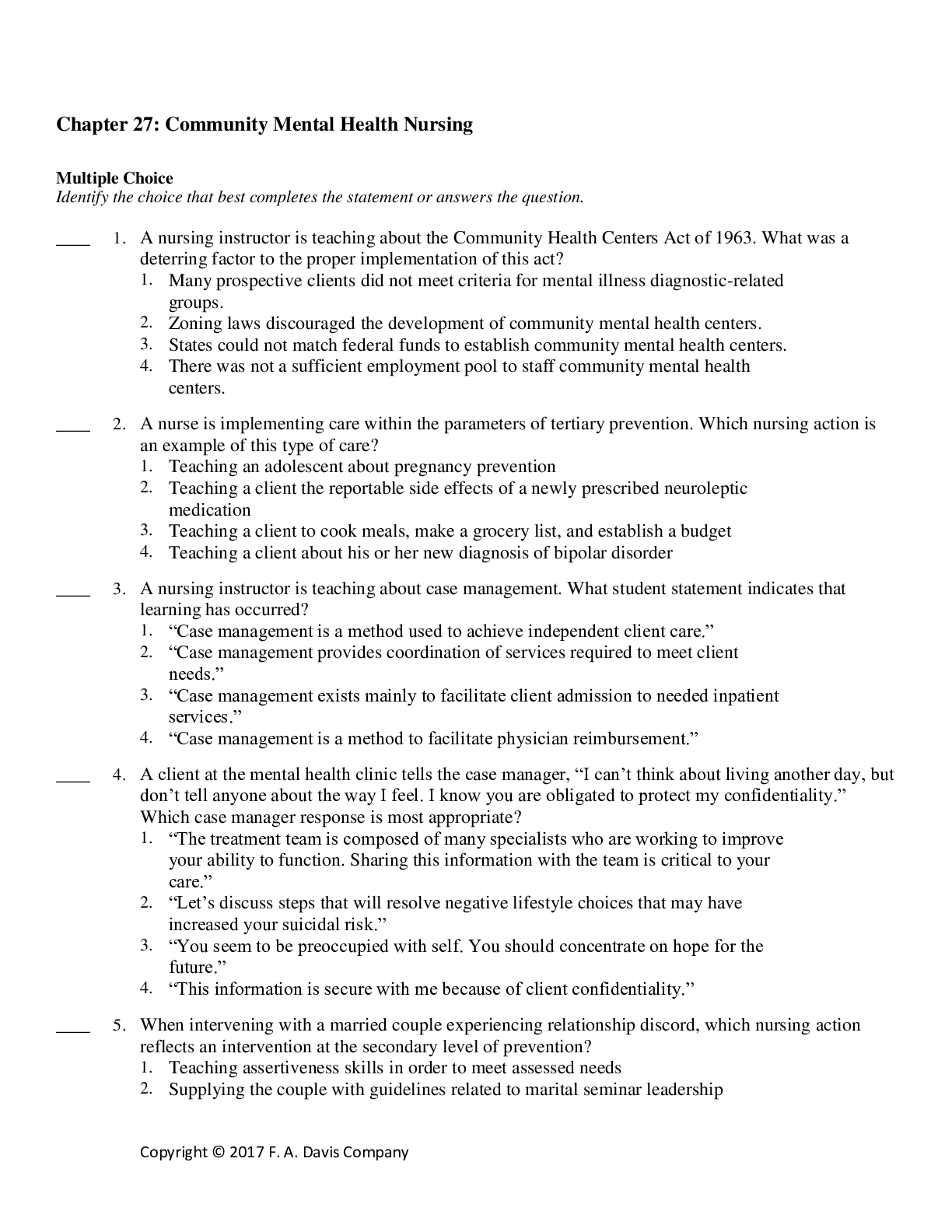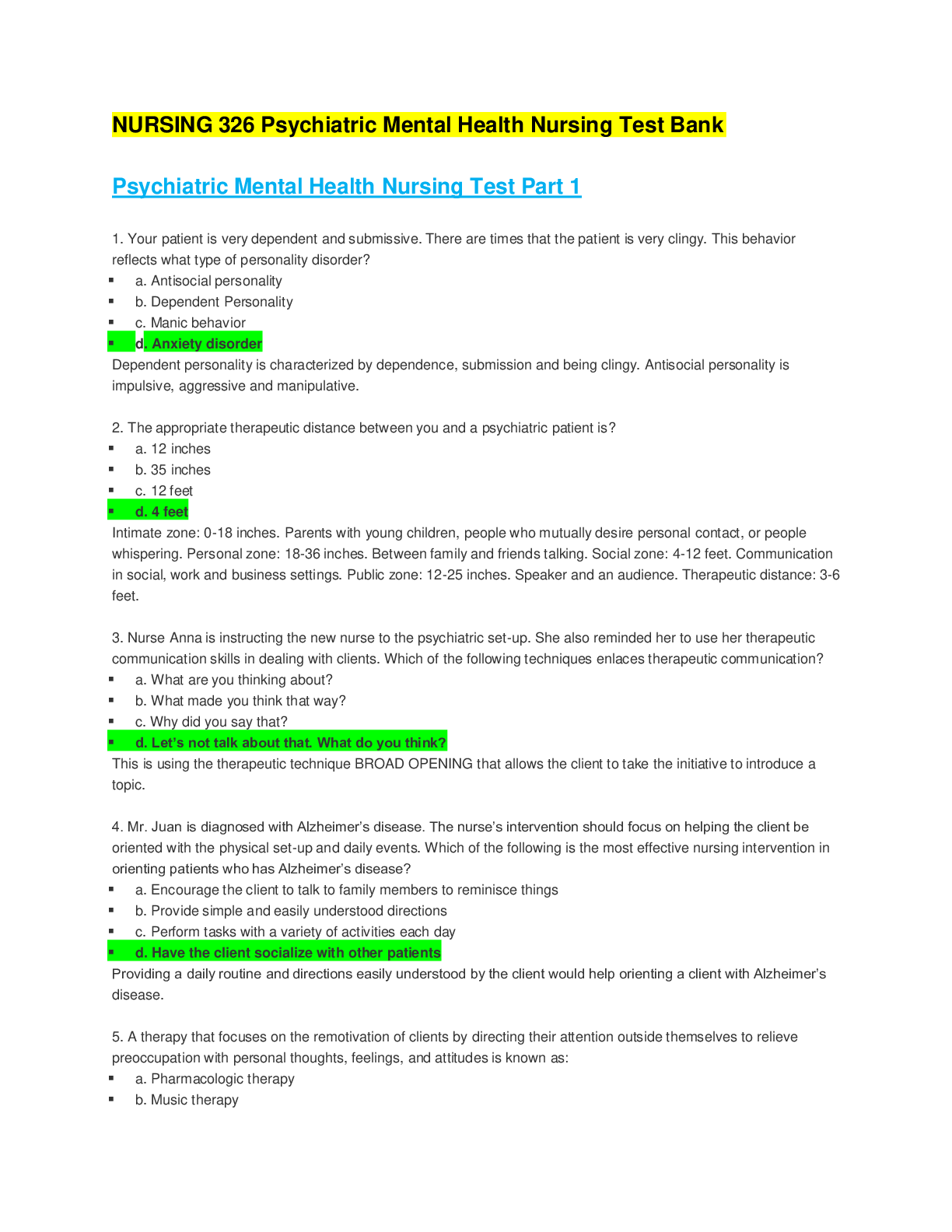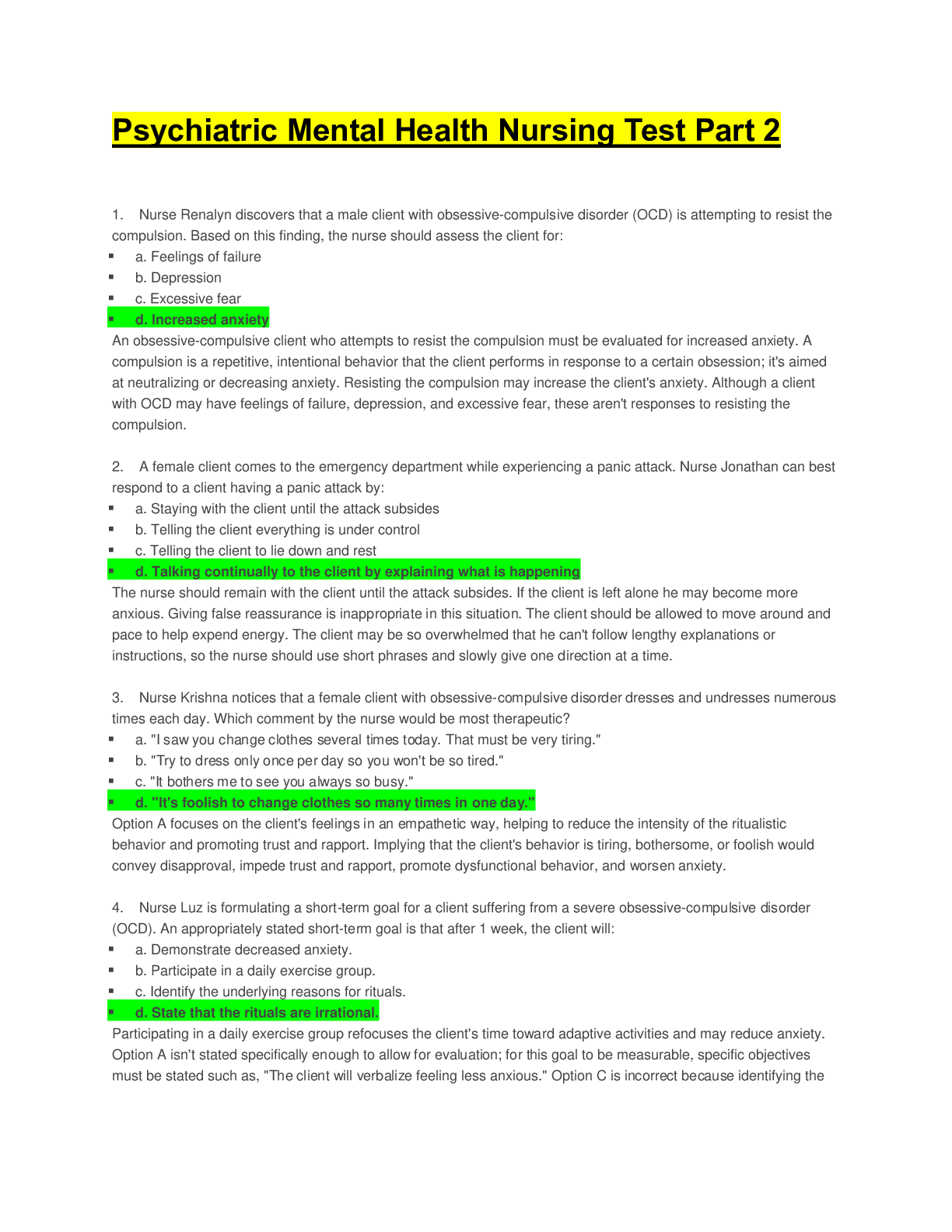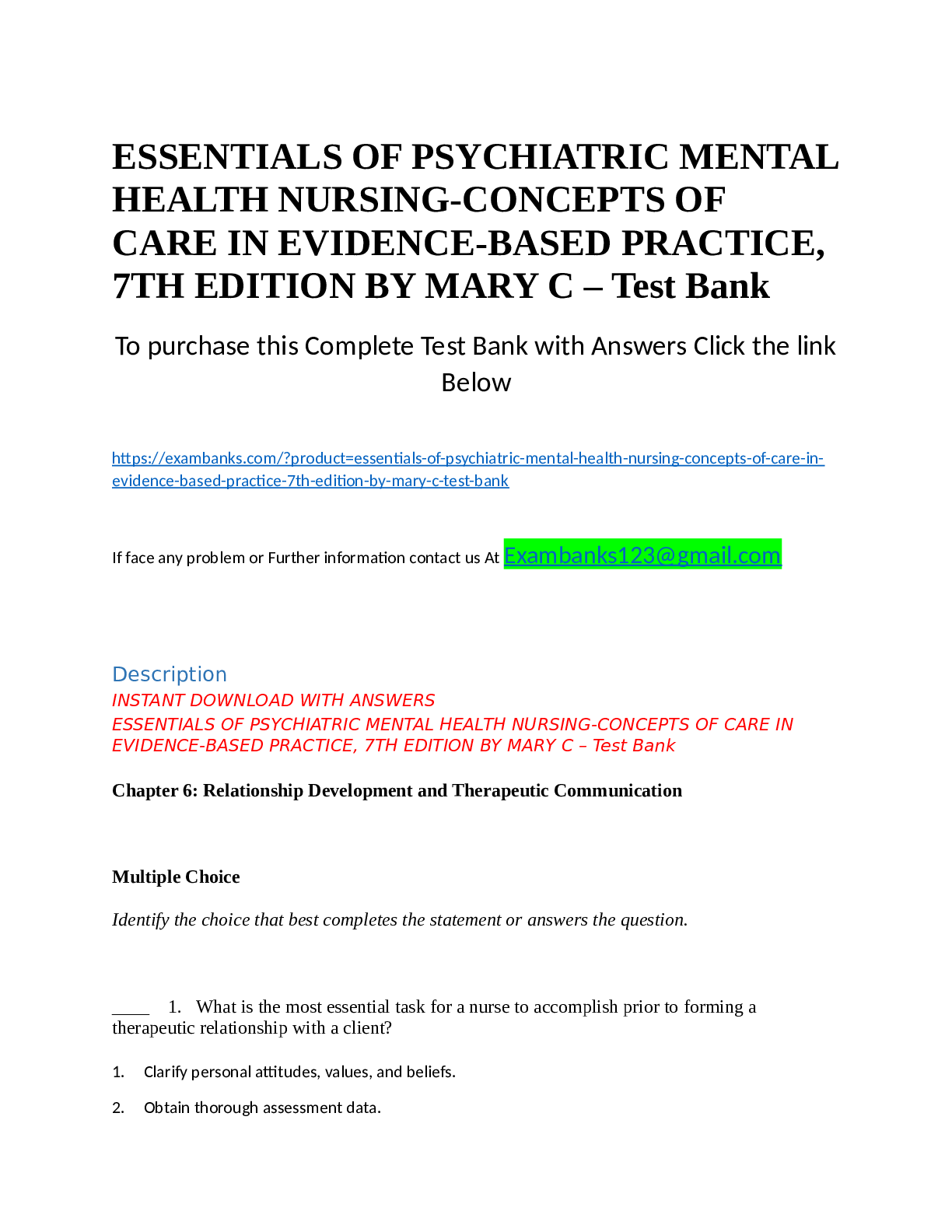*NURSING > QUESTIONS & ANSWERS > Strayer University - NURS NURSINGBasic Concepts Of Psychiatric Mental Health Nursing 8th Edition (All)
Strayer University - NURS NURSINGBasic Concepts Of Psychiatric Mental Health Nursing 8th Edition
Document Content and Description Below
Basic Concepts Of Psychiatric Mental Health Nursing 8th Edition Test Bank Chapter 3- Development of Psychiatric-Mental Health Nursing Theory 1. When the mental health nurse assesses her client,... who has been admitted to an inpatient psychiatric unit for depression, she takes into account that the family will not have income while the client is hospitalized. This assessment by the nurse regarding the impact of client’s hospitalization on the family system can best be described as what? 2. The nursing theorist Peplau identified which of the following as the essence of psychiatric–mental health nursing? 3. The nurse views her client as an individual who has self-care deficits that need to be addressed. The nurse works with the client to assist him or her to meet self-care needs, such as personal grooming, until the client can care for himself or herself independently. This is an example of which of the following theoretical approaches? 4. A psychiatric–mental health nurse gathers information from several nursing theories and combines the client’s resources as a unique person with the most suitable theoretical model. The nurse is using which of the following approaches to applying theory to practice? 5. The theoretical terms “meaning, rhythmicity, and transcendence” are components of which of the following nursing theorists’ work? 6. A client who had a stroke is experiencing left-sided paralysis. The client has become increasingly depressed because of this inability to complete all his ADLs by himself. This inability is considered a self-care deficit according to which nursing theory? 7. A female client is being seen in the emergency room after being physically abused by her husband. The nurse, acting as an advocate for the client, explains to the client the importance of being empowered to leave the abusive situation. Which of the following theorists’ works most explicitly promotes empowerment of the client? 8. According to Roy’s Theory of Adaptation, coping behaviors occur in four adaptive modes. Which of the following is incongruent with the classification of an adaptive mode? 9. The mental health nurse is teaching a client about a psychotropic medication that he has prescribed. The nurse, in this instance, is functioning with which type of approach to nursing practice? A) Needs B) Interaction C) Outcome D) Eclectic Ans: B Feedback: The interaction-oriented approach is used by nurses who rely on interactions and include themselves in the sphere of their actions. They counsel, guide, and teach clients, helping them to find meaning in their situations. The needs-oriented approach encompasses the nurse performing physiologic and psychosocial activities for the client. The outcome-oriented approach focuses on maintaining and promoting energy and harmony with the environment. The eclectic approach is an individualized style that incorporates the client’s own resources as a unique person with the most suitable theoretical model. 10. A mental health nurse is discussing potentially adverse effects of electroconvulsive therapy (ECT). According to Peplau’s Interpersonal Theory, the nurse is functioning in which of the following nursing roles? 11. The nurse is providing care for a client of Chinese descent who has been admitted to the hospital for the treatment of depression. It has become clear during the client’s time of stay in the hospital that the client and his family understand his illness and treatment options in a way that is informed by their culture. Which of the following nursing theorists prioritizes the role of culture in assessment and care? 12. Carolyn’s course of treatment for anorexia nervosa has been largely unsuccessful, a fact that has caused frustration for some members of the interdisciplinary team. Which of the following statements would suggest that the team plans to implement the Tidal Model in Carolyn’s treatment? 13. Which of the following statements most accurately summarizes the basis of the Tidal Model? 14. A psychiatric–mental health nurse is providing care for a client who lives in the community. Which of the following preconditions is necessary before Peplau’s Interpersonal Theory becomes an accurate framework for the nurse’s practice? 15. Hans has schizophrenia and uses marijuana heavily. His living situation has been unstable in recent years, and he has been living in a rooming house for the past several months. His landlord, however, has contacted the home health nurse because of the squalor of Hans’ room and frequent disturbances. What aspect of Hans’ situation would be prioritized within the framework of Orem’s Behavioral Nursing Theory? 16. The wife of a client has said about her husband, “I think that what it comes down to is that he really has a hard time processing and accommodating the pressures and stressors that come at him as he goes through his life.” The nurse should recognize that the wife’s statement summarizes the theoretical perspective of which theorist? 17. A new program has been launched with the goal of fostering the development of life skills for community-dwelling clients with mental illness, aiming to teach them how to shop, cook, and manage money more effectively. This program demonstrates what approach to practice? 18. Which of the following statements best empowers a nursing student to develop and implement the eclectic approach to nursing? 19. After many years of intravenous heroin use, Scott has been admitted to an inpatient treatment facility. An application of Leininger’s theory of nursing would emphasize which of the following aspects of Scott’s life? 20. Which of the following statements best describes the relationship between nursing theory and nursing research? Chapter 5- Ethical and Legal Issues 1. A client undergoing a colonoscopy tomorrow is receiving preoperative teaching regarding the procedure. Which of the following nursing tasks best describes the explanation of the procedure and the associated risks and benefits? 2. A client has just been explained the reason that he must undergo an MRI. When the nurse asks the client if he understands the teaching, he correctly describes what has been said to him. The client is said to be what? 3. When promoting client safety on an inpatient psychiatric unit, which of the following interventions would be used as the measure of last resort? 4. An 86-year-old male admitted for appendectomy is being discharged to a nursing care facility. He has been diagnosed with depression during this hospitalization. According to the Omnibus Reconciliation Act (OBRA), regarding placement of clients in long-term care (LTC) facilities, which of the following statements is accurate? 5. The depressed client is deciding which type of treatment would be beneficial for him. The nurse would document that the patient is utilizing which of the following ethical principles in this situation? 6. A mental health nurse is caring for a client with an anxiety and substance use disorder. The family is requesting to see the client’s records. The nurse understands that this would be a violation of which law? 7. Malpractice is a type of negligence. The nurse recognizes the elements constituting malpractice as including all of the following except which one of the following? 8. An agitated client has been put in restraints against his will because of inadequate staffing. The nurse determines this as which form of malpractice? 9. According to the Tarasoff vs. Regents of the University of California decision, which of the following takes precedence when a client admits to wanting to kill another person? 10. A client with mental retardation has been accused of first-degree murder. There has been a plea of diminished capacity. Which of the following describes diminished capacity? 11. A client who was deemed to be at high risk for suicide was ordered visual checks every 15 minutes. Nurse K. had been performing these checks since the beginning of her shift but neglected to pass off this responsibility to a colleague before leaving the unit for her scheduled break. As a result, the client made a suicide attempt while Nurse K. was off the unit. Which ethical principle has Nurse K. most clearly violated? 12. Matt is a 41-year-old client who has a long history of intravenous heroin and cocaine use. He has been admitted to the hospital for the treatment of endocarditis and is adamant that his current pain control regimen is inadequate. Some nurses on the unit are suspicious of Matt’s motives and suspect that he is “drug seeking.” How should the nurse begin the process of applying Chally and Loriz’s model for resolving ethical dilemmas? 13. Bella is a client with a complex medical and psychiatric history. Her current hospital admission is for the treatment of traumatic injuries that she received when she was hit by a car. Bella consistently rates her pain level at 10/10, and most members of the care team suspect that she overstates her pain. Which of the following considerations should be the highest priority in the management of Bella’s pain? 14. Rebecca, a 30-year-old client, has been asked to participate in a drug trial. Which of Rebecca’s following statements suggests a possible violation of ethical standards? 15. While performing the admission assessment of a new client, the nurse observed that the client brought a bottle of over-the-counter pain medication to the hospital. The nurse failed to document this or remove the medication from the room. Subsequently, the client experienced a serious adverse drug reaction as a result of the interaction between this drug and one of the drugs that she was prescribed in the hospital. This nurse may be guilty of what? 16. Susan, aged 22, has voluntarily sought treatment for an eating disorder at a residential facility in an isolated rural location. Despite a promising start, she has been involved in recent conflicts with staff members and insists that she wants to leave the facility. Staff members have refused to facilitate her transportation from the facility and have stated that they will not return her money and identification that were held when she was admitted. Staff at the treatment facility may be guilty of false imprisonment because of what fact? 17. A hospital patient has attributed his long-standing struggle with depression to the fact that he was sexually abused by his father as a child and early adolescent. The patient has admitted to the nurse that he intends to seek out his father and “do some justice.” What is the nurse’s primary responsibility in response to the patient’s threat? 18. Which of the following clients most likely has the legal right to refuse treatment? 19. Ali has been admitted to the hospital involuntarily for the treatment of depression. Which of the following criteria provides legal justification for Ali’s involuntary admission? 20. As a result of the increasing severity of her delusions and consequent unsafe behavior, a client has been admitted to a psychiatric facility and judged incompetent to make decisions. Who will now make decisions for the client? [Show More]
Last updated: 2 years ago
Preview 1 out of 15 pages
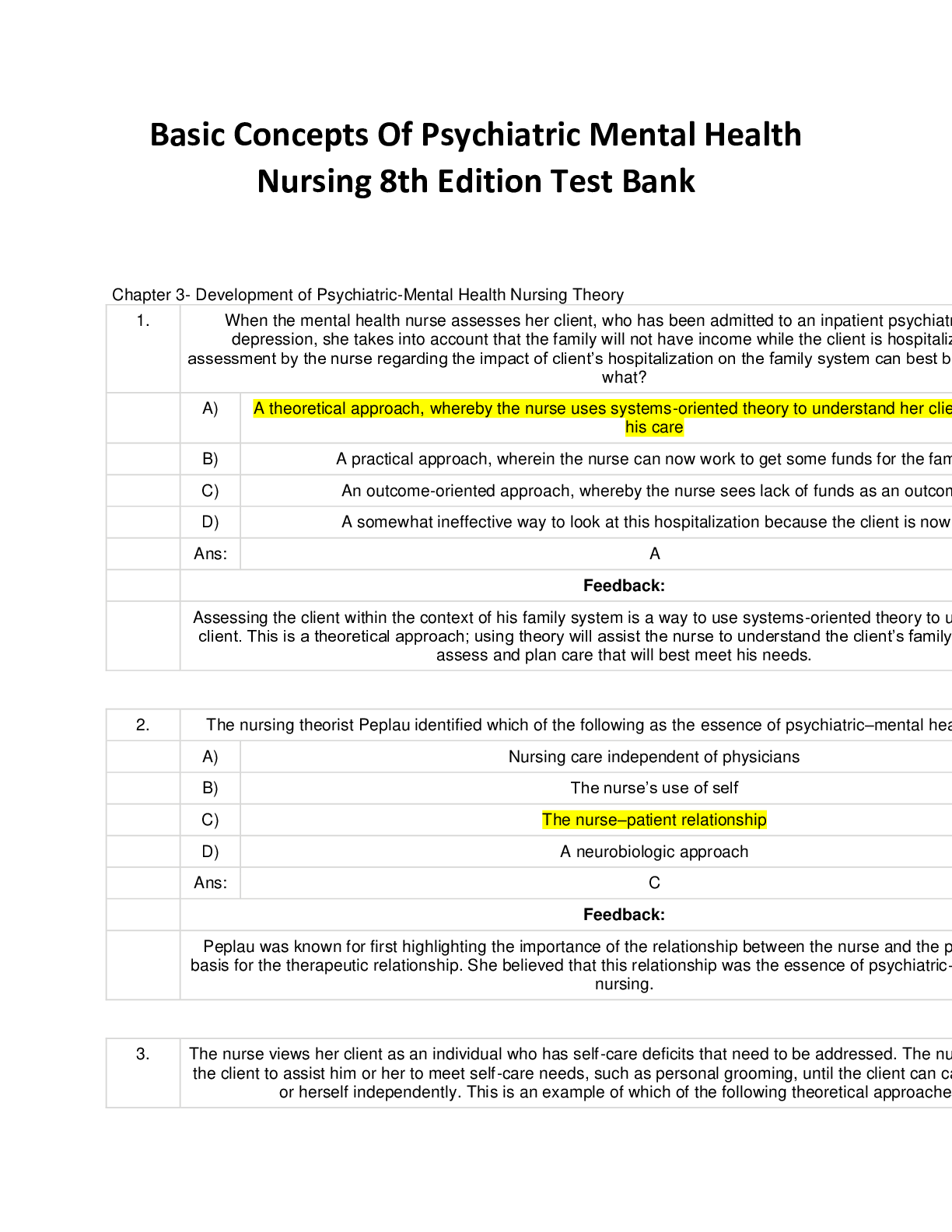
Buy this document to get the full access instantly
Instant Download Access after purchase
Buy NowInstant download
We Accept:

Reviews( 0 )
$6.00
Can't find what you want? Try our AI powered Search
Document information
Connected school, study & course
About the document
Uploaded On
Apr 23, 2020
Number of pages
15
Written in
Additional information
This document has been written for:
Uploaded
Apr 23, 2020
Downloads
0
Views
89

